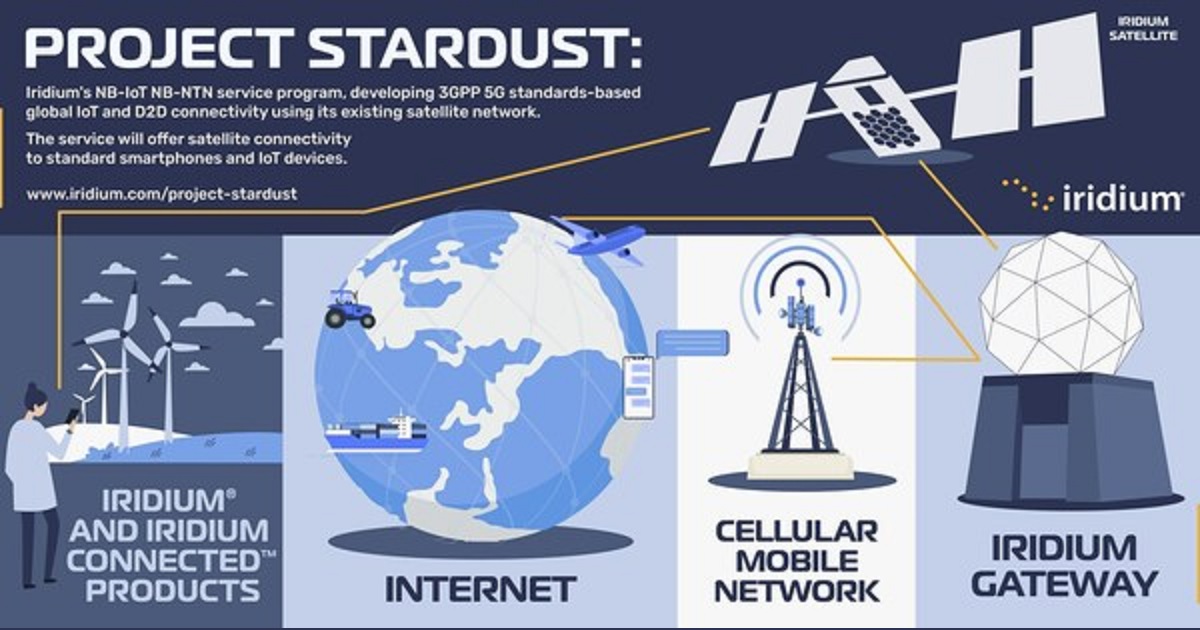
Network Infrastructure
PR Newswire | January 12, 2024
Iridium Communications Inc., a leading provider of global voice and data satellite communications, today announced Project Stardust, the evolution of its direct-to-device (D2D) strategy with 3GPP 5G standards-based Narrowband-Internet of Things (NB-IoT) Non-Terrestrial Network (NB-NTN) service development. As a new standards-based solution, it will be deployed on Iridium's existing satellite network giving the company a unique ability to offer both high-quality proprietary and standardized D2D and IoT services to its customers.
The early stages of programming Iridium's low-Earth orbiting (LEO) satellites offers a special opportunity to smartphone companies, OEMs, chipmakers, mobile network operators (MNO) and related IoT developers to have their requirements woven into the fabric of the Iridium® network. Iridium is already collaborating directly with several of these companies.
"This is an exciting moment for Iridium and is a testament to the flexibility and capability built into our satellite constellation," said Iridium CEO Matt Desch. "The industry is moving quickly towards a more standards-based approach, and after surveying the field, we found that we're the best positioned to lead the way using our own network, particularly given our true global coverage."
Iridium is designing its initial NB-IoT offering to support 5G NTN messaging and SOS capabilities for smartphones, tablets, cars, and related consumer applications. Adopting the service will enable device manufacturers to add a satellite connection to standardized devices, take advantage of existing, globally allocated and coordinated Iridium spectrum, and provide a superior low-latency LEO user experience. The Iridium network supports approximately 1,300 SOS and emergency (911 or equivalent) incidents per year, around the world and has readily available systems, processes, and partners to implement this capability for new devices.
Iridium understands the market need for its customers to develop and certify products quickly. Applying our established onboarding processes, chipmakers and NB-IoT developers can join Iridium's ecosystem of about 500 partners, and choose a proprietary, standards-based, or dual-solution integration approach for added network redundancy. MNOs will have the opportunity to be a one-stop shop for ubiquitous coverage and off-grid use cases, with unmatched industry reliability. Iridium partners are supported by a 24/7 customer support, back office, billing, and provisioning system, all ready to support the new service upon launch.
The Iridium satellite constellation's fully crosslinked, LEO architecture and global L-band spectrum provides a competitive service advantage versus other LEO and geostationary satellite networks. Certified to provide safety of life services by international regulatory bodies, the Iridium network has become the gold standard of reliability and continues to be the only network that provides connectivity everywhere on Earth. Operating in LEO, the Iridium constellation does not suffer from the same line-of-sight limitations, significant power requirements or outages that can affect entire regions from a single satellite as faced by geostationary systems.
The recognized leader in satellite IoT and personal communications, Iridium has more than two decades of experience and an unmatched partner ecosystem supporting more than 2.2 million users around the world. As of the third quarter of 2023, Iridium subscribers have grown at a 15% CAGR over the last five years, and the company serves approximately 1.7 million IoT customers today, including about 900,000 personal trackers and satellite messengers for consumer, enterprise, and government applications. Known for its reliability, coverage, and low power requirements, the Iridium network is an ideal fit for NB-IoT NTN service.
The company is currently working with several D2D and IoT-focused companies to understand and incorporate their use cases, requirements, and end-user needs into its planned service. The company anticipates testing to begin in 2025, with service in 2026.
About Iridium Communications Inc.
Iridium® is the only mobile voice and data satellite communications network that spans the entire globe. Iridium enables connections between people, organizations and assets to and from anywhere, in real time. Together with its ecosystem of partner companies, Iridium delivers an innovative and rich portfolio of reliable solutions for markets that require truly global communications. In 2019, the company completed a generational upgrade of its satellite network and launched its specialty broadband service, Iridium Certus®. Iridium Communications Inc. is headquartered in McLean, Va., U.S.A., and its common stock trades on the Nasdaq Global Select Market under the ticker symbol IRDM.
Read More

Network Infrastructure
PR Newswire | January 15, 2024
DriveNets – a leader in innovative networking solutions – and Acacia today announced the completion of integrating multiple Acacia 400G ZR/ZR+ optical modules with DriveNets' Network Cloud platform. The combined DriveNets-Acacia solution will ensure quick adoption of this innovative disaggregated networking solution and accelerate large-scale network rollouts. DriveNets and Acacia have joint Tier-1 operator customers who will deploy the joint solution.
Last September, DriveNets announced that Network Cloud was the first Disaggregated Distributed Chassis/Backbone Router (DDC/DDBR) to support ZR/ZR+ optics as native transceivers that can be inserted into any Network Cloud-supported white boxes. The combined Acacia-DriveNets solution announced today adds the initial collaboration between the companies, offering several benefits:
The joint solution will deliver significant simplicity and cost savings by collapsing Layer-1 to Layer-3 communications into a single platform.
The use of 400ZR/ZR+ eliminates the need for standalone optical transponders, lowering the number of boxes in the solution, and reducing operational-overhead, floor-space, and power.
DriveNets and Acacia worked together to ensure that the DriveNets NOS (DNOS) supports the 400ZR/ZR+ modules beyond simply plugging them into the box. The collaboration ensures the 400ZR/ZR+ modules can be tunable, configurable, and manageable by DriveNets Network Cloud software.
This integration also goes beyond interoperability validation. DriveNets Network Cloud offers full software support for the Acacia modules, including configuration (channel and power), monitoring, and troubleshooting for Acacia Bright 400ZR+ transceivers with transmit power greater than +1dBm.
"Today's announcement is further proof of the growth of disaggregated networking solutions and demonstrates that more operators are looking for open solutions that will allow them to mix elements from multiple vendors and avoid being locked to a specific end-to-end vendor solution," said Nir Gasko, Vice President, Global Strategic Alliances for DriveNets. "By collaborating with Acacia, we enable our joint customers to quickly adopt cutting-edge technologies and evolve their networks faster."
"Partnering with DriveNets on this joint solution will allow network operators to deploy Acacia's high-volume standard-based coherent pluggable portfolio in open disaggregated networks with less effort," said Fenghai Liu, Senior Director of Product Line Management for Acacia. "Through this collaboration customers can achieve significant capex and opex savings with router-based coherent optics."
DriveNets Network Cloud is being adopted by more Tier-1 operators around the world. By partnering with world-class providers like Acacia, the company continues to expand its ecosystem to support its customers' desire to mix-and-match hardware and software from multiple vendors.
Learn more about DriveNets here.
About DriveNets
DriveNets is a leader in high-scale disaggregated networking solutions. Founded in 2015, DriveNets modernizes the way service providers, cloud providers and hyperscalers build networks, streamlining network operations, increasing network performance at scale, and improving their economic model. DriveNets' solutions – Network Cloud and Network Cloud-AI – adapt the architectural model of hyperscale cloud to telco-grade networking and support any network use case – from core-to-edge to AI networking – over a shared physical infrastructure of standard white-boxes, radically simplifying the network's operations and offering telco-scale performance and reliability with hyperscale elasticity. DriveNets' solutions are currently deployed in the world's largest networks.
Read More

Network Security
PR Newswire | January 25, 2024
Cato Networks, the leader in SASE, announced the expansion of the Cato SASE Cloud platform into threat detection and incident response with Cato XDR, the world's first SASE-based, extended detection and response (XDR) solution. Available immediately, Cato XDR utilizes the functional and operational capabilities of the Cato SASE Cloud to overcome the protracted deployment times, limited data quality, and inadequate investigation and response experience too often associated with legacy XDR solutions.
Cato also introduced Cato EPP, the first SASE-managed endpoint protection platform (EPP/EDR). Together, Cato XDR and Cato EPP mark the first expansion beyond the original SASE scope pioneered by Cato in 2016 and defined by industry analysts in 2019. SASE's security capabilities encompassed threat prevention and data protection in a common, easy-to-manage, and easy-to-adopt global platform. With today's announcement, Cato is expanding SASE into threat detection, incident response, and endpoint protection without compromising on the architectural elegance captured by the original SASE definition.
"Cato SASE continues to be the antidote to security complexity," says Shlomo Kramer, CEO and co-founder of Cato Networks. "Today, we extend our one-of-a-kind SASE platform beyond threat prevention and into threat detection and response. Only Cato and our simple, automated, and elegant platform can streamline security this way."
An early adopter of Cato XDR is Redner's Markets, an employee-owned supermarket chain headquartered in Reading, Pennsylvania, with 75 locations. Redner's Markets' vice president of IT and Infrastructure, Nick Hidalgo, said, "The Cato platform gave us better visibility, saved time on incident response, resolved application issues, and improved network performance ten-fold." (Read more about Redner's Markets and Cato in this blog.
"The convergence of XDR and EPP into SASE is not just another product; it's a game-changer for the industry," said Art Nichols, CTO of Windstream Enterprise, a Cato partner. "The innovative integration of these capabilities brings together advanced threat detection, response capabilities, and endpoint security within a unified, cloud-native architecture—revolutionizing the way enterprises protect their networks and data against increasingly sophisticated cyber threats." (Read more about what Cato partners are saying about today's news in this blog.)
Platform vs. Product: The Difference Matters
Cato XDR takes full advantage of the enormous benefits of the Cato SASE Cloud platform, the first platform built from the ground up to enable enterprises to connect, secure, and manage sites, users, and cloud resources anywhere in the world.
Unlike disjointed point solutions and security appliances, Cato capabilities are instantly on, always available at scale, and fully converged, giving IT teams a single, shared context worldwide to understand their networks, prevent threats, and resolve problems. As an autonomous platform, Cato SASE Cloud sustains its evolution, resiliency, optimal performance, and security posture, saving enterprises the operational overhead of maintaining enterprise infrastructure. Enterprises simply subscribe to Cato to meet their business needs.
Cato's cloud-native model revolutionized security and networking operations when it was introduced in 2016, a fact validated three years later in 2019 when the Cato approach was formally recognized by the industry as SASE.
Breach Times Still Too Long; Limitations of Legacy XDR
Cato is again revolutionizing cybersecurity with the first SASE platform to expand into threat detection, empowering security teams to become smarter and remediate incidents faster.
The flood of security alerts triggered by network sensors, such as firewalls and IPS, complicates threat identification. In 2023, enterprises required 204 days on average to identify breaches.1 XDR tools help security analysts close this gap by ingesting, correlating, and contextualizing threat intelligence information with the data from native and third-party sensors.
However, legacy XDR tools suffer from numerous problems relating to data quality. Sensor deployment extends the time-to-value as IT must not only install the sensors but also develop a baseline of specific organizational activity for accurate assessments. Data quality is also compromised when importing and normalizing third-party sensor data, complicating threat identification and incident response.
Security analysts waste time sorting through incident stories to identify the ones most critical for immediate remediation. Once determined, incident remediation is often hampered by missing information, requiring analysts to master and switch between disparate tools. No wonder in 2023, average breach containment required more than two months.1
Cato XDR and Cato EPP Expands the Meaning of SASE
Cato XDR addresses legacy XDR's limitations. Instantly activated globally, Cato XDR provides enterprises with immediate insights into threats on their networks. Incident detection is accurate due to Cato's many native sensors – NGFW, advanced threat prevention (IPS, NGAM, and DNS Security), SWG, CASB, DLP, ZTNA, RBI, and now EPP/EDR. Powered by Bitdefender's world-leading malware prevention technology, Cato EPP protects endpoints from attack – in the Cato way. Endpoint threat and user data are stored in the same converged Cato data lake as the rest of the customer's network data, simplifying cross-domain event correlation.
The result is incredibly high-quality data that improves the incident identification and remediation process. Cato AI uses the data to accurately identify and rank incidents, empowering analysts to focus critical resources on an organization's most important remediation cases. Cato AI is battle-tested and proven across years of threat hunting and remediation handling by Cato MDR service agents.
Remediation times reduce as detected incident stories contain the relevant information for in-depth investigation. Cato's tools sit in the same console as the native engines, enabling security analysts to view everything in one place -- the current security policy and the reviewed story.
Finally, incident reporting is simplified with generative AI. Purpose-built for investigations, this natural language engine provides human-readable explanations of incident stories. Analysts save time sharing incident information with other teams and reporting to their managers.
Read More